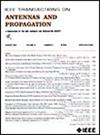Omnidirectional Printed Filtering Antenna and MIMO Array Using Folded Structures
IF 5.8
1区 计算机科学
Q1 ENGINEERING, ELECTRICAL & ELECTRONIC
引用次数: 0
Abstract
A printed omnidirectional filtering antenna is investigated without using any extra filtering circuits. The antenna consists of three folded structures: one narrow closed loop and two split loops. One of the split loops has a narrow width with its opening at the bottom, while the other split loop has a wider width with its opening at the top. The latter features folded PIFA-like structures. All these structures are connected in parallel and etched on a one-layer substrate. Due to the field’s cancellation, the design generates three radiation nulls near the passband, realizing filtering responses. The antenna achieves a measured −10-dB impedance bandwidth of 12.0% and exhibits omnidirectional radiation patterns. Its measured total efficiency within the passband is 87.4%, while the suppression level in the stopband exceeds 18.8 dB. This basic omnidirectional filtering design is extended to multiple input multiple output (MIMO) array designs. By loading decoupling meander lines between closely spaced elements (采用折叠结构的全向印刷滤波天线和MIMO阵列
研究了一种不使用任何额外滤波电路的印刷全向滤波天线。该天线由三个折叠结构组成:一个窄闭环和两个分裂环。其中一个分割环的宽度较窄,其底部开口,而另一个分割环的宽度较宽,其顶部开口。后者具有折叠的pifa样结构。所有这些结构并联连接并蚀刻在单层基板上。由于场的对消,设计在通带附近产生了三个辐射零点,实现了滤波响应。该天线实现了−10db的测量阻抗带宽为12.0%,并呈现全向辐射方向图。其通带内的实测总效率为87.4%,阻带内的抑制电平超过18.8 dB。这种基本的全向滤波设计扩展到多输入多输出(MIMO)阵列设计。通过在紧密间隔的元件之间加载去耦曲线($\lt 0.02\lambda _{0}$),端口隔离度提高了9.6 dB以上。此外,畸变的辐射方向图也得到了显著改善。制作了$1\ × 4$ MIMO阵列的原型并进行了测试以验证该想法。仿真结果与实测结果吻合较好。该MIMO阵列的耦合小于- 19.8 dB,矩形系数小于1.35。与已有的全向研究相比,我们的设计在频率选择性、全向辐射方向图的稳定性和天线元件的可扩展性方面具有优势。
本文章由计算机程序翻译,如有差异,请以英文原文为准。
求助全文
约1分钟内获得全文
求助全文
来源期刊
CiteScore
10.40
自引率
28.10%
发文量
968
审稿时长
4.7 months
期刊介绍:
IEEE Transactions on Antennas and Propagation includes theoretical and experimental advances in antennas, including design and development, and in the propagation of electromagnetic waves, including scattering, diffraction, and interaction with continuous media; and applications pertaining to antennas and propagation, such as remote sensing, applied optics, and millimeter and submillimeter wave techniques

 求助内容:
求助内容: 应助结果提醒方式:
应助结果提醒方式:


